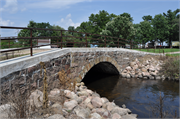Property Record
810 COUNTY ROAD B
Architecture and History Inventory
| Historic Name: | Main Street Bridge (P-68-015) |
|---|---|
| Other Name: | |
| Contributing: | |
| Reference Number: | 238727 |
| Location (Address): | 810 COUNTY ROAD B |
|---|---|
| County: | Waupaca |
| City: | Scandinavia |
| Township/Village: | |
| Unincorporated Community: | |
| Town: | 23 |
| Range: | 11 |
| Direction: | E |
| Section: | 15 |
| Quarter Section: | |
| Quarter/Quarter Section: |
| Year Built: | 1906 |
|---|---|
| Additions: | |
| Survey Date: | 2018 |
| Historic Use: | bridge |
| Architectural Style: | NA (unknown or not a building) |
| Structural System: | Masonry Arch |
| Wall Material: | Granite Stone |
| Architect: | Mortimer Lovdahl, Tengel Evenson, and Thomas Norestad, contractors |
| Other Buildings On Site: | |
| Demolished?: | No |
| Demolished Date: |
| National/State Register Listing Name: | Not listed |
|---|---|
| National Register Listing Date: | |
| State Register Listing Date: |
| Additional Information: | 2018- The Main Street Bridge is located in the Village of Scandinavia in Waupaca County. It was built in 1906 by Mortimer Lovdahl, Tengel Evenson, and Thomas Norestad. The designer has not been identified. The structure is a rock-faced, ashlar-granite, segment-arch bridge with sandstone ring stones, metal pipe railings, cast-rion drain spouts in the spandrel walls, and slightly flared wing walls at both ends. Springing at the waterline, the arch rises about 5 feet over a span of about 21 feet. The bridge’s length, excluding wing walls, is about 24 feet; its width about 20 feet. Of the 45 stone-arch, country bridges known to have been constructed in Waupaca County during 1899-1912, only 9 survive. The Main Street Bridge is one of two, coursed-ashlar, fieldstone (granite) structures remaining. Both were built by the partnership of Lovdahl, Evenson, and Norestad, who apparently were among the few local contractors who shaped the fractious, local fieldstone into coursed-ashlar masonry for bridge work. All other, surviving, Waupaca County stone-arches are of rubble-fieldstone construction. The Main Street Bridge is architecturally significant as a well-designed and well-preserved variant of an important, regional, building type. Its significance is enhanced by its proximity to an excellent example of rubble-fieldstone bridge construction (AHI #238729, Mill Street Bridge) about one-half mile downstream, also in the Village of Scandinavia. Together, these two bridges document the regional tradition of stone-arch bridge construction that flourished in Waupaca County during the first decade of the twentieth century. In February 1906, the Scandinavia Village Board voted to “build a stone bridge over the south branch of the Little Wolf River at the head of Main Street,” near the northern limit of the village. Plans and specifications were secured from A. A. Ramlet, a Waupaca County contractor who built a stone-arch bridge in the nearby Town of Farmington that same year. Although the village board voted “that cement [i.e. concrete] be used exclusively,” it found that a bid for stone-arch construction was cheaper. It therefore awarded a contract for a stone bridge to a partnership consisting of Mortimer Lovdah, Tengel Evenson, and Thomas Norestad, all from the nearby Village of Iola. The bridge was accepted by the Village Board in August 1906 for a total cost of $1,442.30. The bridge’s construction was part of a general economic boom that saw the establishment of a bank (1900) and telephone company (1903), as well as the completion of another stone-arch bridge in the center of the village in 1907. Containing about 450 people, mostly of Norwegian descent, the village was also the home of the Scandinavia Academy, a Norwegian Lutheran seminary founded in 1891. Located just west of the Academy’s grounds, the Main Street Bridge provided the school with improved access to the west side of the river. It remained in use until 1956, when the route of County Road B leading into the village was straightened, and a new, concrete bridge was built just to the south of the old stone arch. Currently, Main Street Bridge serves as a pedestrian crossing in a small village park. In addition to its local importance as a community landmark, the bridge has state-wide significance as evidence of the economically competitive nature of stone-arch construction during the early twentieth century. |
|---|---|
| Bibliographic References: | Hess, Jeffrey A. and Robert M. Frame, III. "Historic Highway Bridges in Wisconsin, Volume I: Stone and Concrete Arch Bridges." Wisconsin Department of Transportation, 1986. |
| Wisconsin Architecture and History Inventory, State Historic Preservation Office, Wisconsin Historical Society, Madison, Wisconsin |

